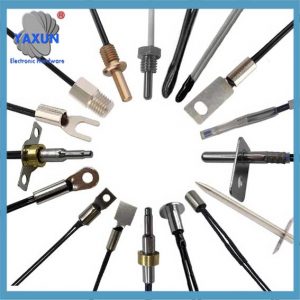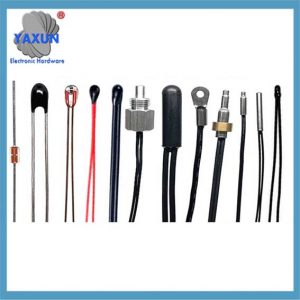When faced with thousands of NTC thermistor types, choosing the right one can be quite overwhelming. In this technical article, I will walk you through some of the important parameters to keep in mind when selecting a thermistor. This is especially true when deciding between the two common types of thermistors used for temperature sensing: negative temperature coefficient NTC thermistors or silicon-based linear thermistors. NTC thermistors are widely used due to their low price, but offer lower accuracy at extreme temperatures. Silicon-based linear thermistors offer better performance and higher accuracy over a wider temperature range, but are generally more expensive. As we will see below, other linear thermistors are coming to market that offer more cost-effective, high-performance options. Helping to address a wide range of temperature sensing needs without increasing the overall cost of the solution.
The right thermistor for your application will depend on many parameters, 如:
· Bill of Materials (BOM) 成本;
· Resistance tolerance;
· Calibration points;
· Sensitivity (change in resistance per degree Celsius);
· Self-heating and sensor drift;
BOM cost
Thermistors themselves are not expensive. Since they are discrete, their voltage drop can be changed by using additional circuitry. 例如, if you are using a nonlinear NTC thermistor and want a linear voltage drop across the device, you might choose to add an additional resistor to help achieve this characteristic. 然而, another alternative that can reduce BOM and total solution cost is to use a linear thermistor that provides the desired voltage drop on its own. The good news is that with our new linear thermistor family, both are possible. This means engineers can simplify designs, reduce system costs, and reduce printed circuit board (印刷電路板) layout size by at least 33%.
Resistance Tolerance
Thermistors are categorized by their resistance tolerance at 25°C, but this does not fully describe how they change over temperature. You can use the minimum, typical, and maximum resistance values provided in the device resistance vs. 溫度 (R-T) table in a design tool or datasheet to calculate the tolerance over a specific temperature range of interest.
To illustrate how tolerances change with thermistor technology, let’s compare an NTC and our TMP61 silicon-based thermistor. They are both rated for a ±1% resistance tolerance. Figure 1 illustrates that the resistance tolerance of both devices increases as the temperature moves away from 25°C, but there is a large difference between the two at the extreme temperatures. It is important to calculate this difference so that you can choose a device that maintains a lower tolerance over the temperature range of interest.
How to Choose the Right Thermistor for Your Temperature Sensor
Figure 1: Resistance Tolerance: NTC vs. TMP61
Calibration Points
Not knowing where the thermistor is within its resistance tolerance range will degrade system performance because you need a wider margin of error. Calibration will tell you what resistance value to expect, which can help you reduce the margin of error significantly. 然而, it is an additional step in the manufacturing process, so calibration should be kept to a minimum.
The number of calibration points depends on the type of thermistor used and the temperature range of the application. For narrow temperature ranges, one calibration point is appropriate for most thermistors. For applications that require a wide temperature range, you have two options: 1) calibrate three times with an NTC (this is due to their low sensitivity at extreme temperatures and higher resistance tolerance). Or 2) calibrate once with a silicon-based linear thermistor, which is more stable than an NTC.
Sensitivity
A large change in resistance per degree Celsius (sensitivity) is just one of the challenges when trying to get good accuracy from a thermistor. 然而, unless you get the resistance value right in the software, either through calibration or by choosing a thermistor with a low resistance tolerance, a large sensitivity won’t help.
NTCs have very high sensitivity at low temperatures because their resistance value decreases exponentially, but they also drop off dramatically as the temperature increases. Silicon-based linear thermistors do not have the same high sensitivity as NTCs, so they provide stable measurements over the entire temperature range. As the temperature increases, the sensitivity of silicon-based linear thermistors typically exceeds that of NTCs at about 60°C.
Self-heating and sensor drift
Thermistors dissipate energy as heat, which can affect their measurement accuracy. The amount of heat dissipated depends on many parameters, including the material composition and the current flowing through the device.
Sensor drift is the amount a thermistor drifts over time, usually specified in the datasheet via an accelerated life test given as a percentage change in resistance value. If your application requires long life with consistent sensitivity and accuracy, choose a thermistor with low self-heating and small sensor drift.
So when should you use a silicon linear thermistor like the TMP61 over an NTC?
Looking at Table 1, you can see that for the same price, you can benefit from the linearity and stability of a silicon linear thermistor in almost any situation within the specified operating temperature range of a silicon linear thermistor. Silicon linear thermistors are also available in commercial and automotive versions and in the standard 0402 和 0603 packages common to surface mount device NTCs.
Table 1: NTC vs. TI silicon linear thermistors
For a complete R-T table for TI thermistors and an easy temperature conversion method with example code, download our Thermistor Design Tool.
 English
English العربية
العربية Български
Български 粤语
粤语 中文(简体)
中文(简体) 中文(漢字)
中文(漢字) Nederlands
Nederlands Suomi
Suomi Français
Français Deutsch
Deutsch Ελληνικά
Ελληνικά Magyar
Magyar Italiano
Italiano 日本語
日本語 한국어
한국어 Polski
Polski Português
Português Română
Română Русский
Русский Slovenščina
Slovenščina Español
Español Svenska
Svenska ภาษาไทย
ภาษาไทย Türkçe
Türkçe Tiếng Việt
Tiếng Việt



